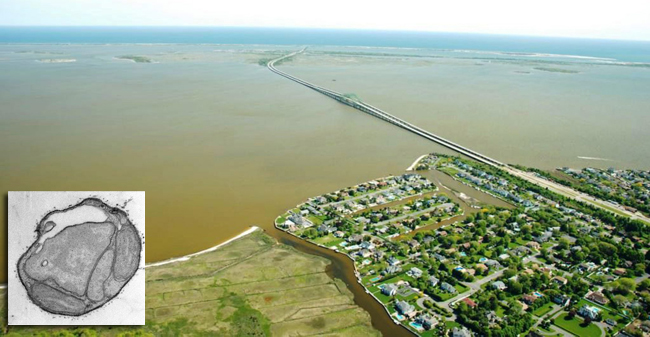Results from a five-year, National Oceanic and Atmospheric Administration (NOAA) National Centers for Coastal Ocean Science (NCCOS)-sponsored research project on brown tide in Long Island Estuaries were highlighted this past summer during a New York Sea Grant virtual seminar
– By Quay Dortch, Ph.D., Senior HAB Scientist, NOAA/NOS/NCCOS/Competitive Research Program, E: quay.dortch@noaa.gov
Stony Brook, NY, July 14, 2020 - Brown tides, caused by the algal species Aureococcus anophagefferens, have been plaguing Long Island estuaries for 35 years, and can have severe impacts on fisheries, seagrass beds, and aquaculture. To date, multiple hypotheses have been put forth to explain the occurrence of these events. Results from a five-year, NCCOS-sponsored research project on brown tide in Long Island Estuaries were highlighted at a recent New York Sea Grant seminar.
The development of more effective management strategies for brown tides requires a deeper understanding of the causes of these blooms. With funding from the NCCOS Ecology and Oceanography of Harmful Algal Blooms (ECOHAB) program, this project examined transcriptomes, or the the entire collection of RNA sequences in a cell produced by the genome of an organism under specific conditions, to determine the causes of brown tides.
In 2016, the Gobler Lab sampled a brown tide during the initiation, peak, and collapse phases of the bloom, while concurrently measuring several environmental parameters and new molecular markers of cellular processes. They conducted experiments to explore how changes in environmental factors, like levels of nutrients or exposure to zooplankton grazing, can alter cell numbers and specific molecular markers in both the brown tide organism, and competing phytoplankton. The results were presented by Dr. Christopher Gobler of Stony Brook University on June 25, 2020, during the New York Sea Grant online seminar.
Generating transcriptomes for Aureococcus cultures allowed researchers to link expression of genes by the brown tide and competing phytoplankton to specific environmental conditions to define the precise niche of each algal species, providing novel insight into how brown tides are developed and sustained.
Major ECOHAB project conclusions regarding Long Island brown tide:
- The mechanism and factors controlling brown tides change over the course of the bloom
- Bloom initiation stage involves rapid growth, DNA and amino acids synthesis, and phosphorus limitation
- Bloom maintenance stage involves cell growth in balance with grazing with lipid synthesis and storage, and nitrogen limitation
- Management of both phosphorus and nitrogen are important in controlling brown tides since brown tide expresses genes to get more P (or N) as the nutrient declines
- Zooplankton grazing elicits strong transcription responses (i.e., gene expression) in brown tide
- Brown tide grazer defenses may promote bloom maintenance

A brown tide bloom in Great South Bay, Long Island, NY. Credit: Dr. Chris Gobler, Stony Brook University. Inset: Thin-section transmission electron microscope (TEM) of Aureococcus anophagefferens. Credit: Roger Anderson, Columbia University.
Another highlight of this seminar: New York Sea Grant, the Suffolk County Department of Health and their partners are asking for your help to document occurrences of Harmful Algal Blooms in NY's marine waters: www.nyseagrant.org/reportHABs.
More Info: New York Sea Grant
New York Sea Grant (NYSG), a cooperative program of Cornell University
and the State University of New York (SUNY), is one of 34 university-based
programs under the National Oceanic and Atmospheric Administration’s
National Sea Grant College Program.
Since 1971, NYSG has represented a statewide network of integrated
research, education and extension services promoting coastal community
economic vitality, environmental sustainability and citizen awareness
and understanding about the State’s marine and Great Lakes resources.
Through NYSG’s efforts, the combined talents of university scientists
and extension specialists help develop and transfer science-based
information to many coastal user groups—businesses and industries,
federal, state and local government decision-makers and agency managers,
educators, the media and the interested public.
The program maintains Great Lakes offices at Cornell University, University at Buffalo, SUNY Oswego and the Wayne County Cooperative Extension office
in Newark. In the State's marine waters, NYSG has offices at Stony Brook
University in Long Island, Brooklyn College and Cornell Cooperative
Extension in NYC and Kingston in the Hudson Valley.
For updates on Sea Grant activities: www.nyseagrant.org has RSS, Facebook, Twitter, Instagram, and YouTube links. NYSG offers a free e-list sign up via www.nyseagrant.org/nycoastlines for its flagship publication, NY Coastlines/Currents, which is published quarterly. Our program also produces an occasional e-newsletter,"NOAA Sea Grant's Social Media Review," via its blog, www.nyseagrant.org/blog.